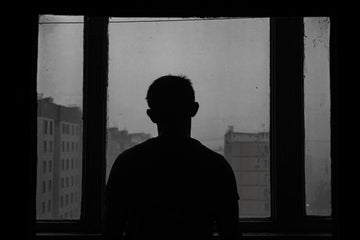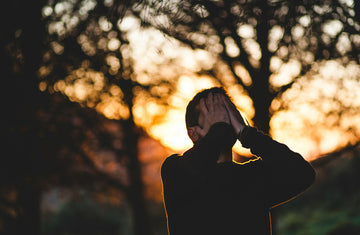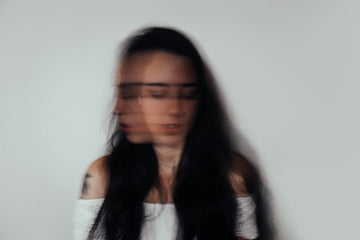The acronym for Seasonal Affective Disorder is appropriate: SAD. This depressive condition affects a small percentage (but still millions) of people.
It affects 0.5-3% of people in the general population. And it hits 10-20% of people with serious depressive disorders and 25% of people with bipolar disorder.
If you suspect that you experience SAD, this post will help you confirm if that’s true and then guide you on how to navigate it.
What Is Seasonal Affective Disorder (SAD)?
Seasonal Affective Disorder (SAD) is a type of depression that comes around at a specific time of year. What Month Does SAD Start? Usually during the fall and winter months, so as early as September, depending on the weather where you live. For this reason, it’s often called “winter depression” or “winter blues.”
Causes of Seasonal Affective Disorder
The exact cause of SAD is not known, but many experts believe it’s related to changes in natural light exposure, which can affect certain chemicals in the brain that play a role in regulating mood and sleep patterns. These would be hormones like serotonin and melatonin.
However, we can make educated guesses about what causes SAD. Below are some of the most probable reasons.
Biological Clock (Circadian Rhythm)
Changes in the amount of sunlight during different seasons can disrupt your body’s internal clock, or circadian rhythm. This disruption may affect the production of certain neurotransmitters, like serotonin and melatonin, which play a role in regulating mood, sleep, and overall well-being.
Latitude and Seasonal Changes
SAD is more common at higher latitudes where there are greater seasonal changes in sunlight. The farther you are from the equator, the more pronounced the seasonal variations in light exposure.
Low Serotonin Levels
Reduced sunlight exposure during the fall and winter months may lead to lower serotonin levels. Serotonin is the “happy” hormone. It’s a neurotransmitter that contributes to feelings of well-being and peace.
Low Melatonin Levels
Reduced sunlight exposure can also affect melatonin production. Melatonin is the “sleep” hormone” because it helps regulate sleep patterns and mood. Changes in melatonin levels may contribute to symptoms of SAD, particularly disruptions in sleep.
Genetic Factors
There may be a genetic predisposition to developing Seasonal Affective Disorder. People with a family history of depression or SAD may be at a higher risk.
Environmental Factors
Other environmental factors, like changes in temperature and reduced outdoor activity during colder months, may also contribute to the development of SAD.
Symptoms of Seasonal Affective Disorder
SAD looks a lot depression, but the key difference is that these symptoms happen in a seasonal pattern, usually during the fall and winter months.
You may not experience all of these, but here are the most common symptoms of SAD:
- Depressed mood
- Loss of interest or pleasure
- Fatigue and low energy
- Sleep disturbances (like hypersomnia insomnia)
- Drastic appetite changes or weight gain
- More difficulty concentrating
- Feelings of worthlessness or guilt
- Increased irritability
- Social withdrawal
- Aches, pains, headaches, and/or stomach problems
How To Navigate Seasonal Affective Disorder
Okay, so you think you have SAD. Now what?
Managing and treating SAD usually involves a combination of lifestyle changes, light therapy, and psychotherapy. Below are some strategies to navigate and treat SAD.
Light Therapy (Phototherapy)
Exposure to bright light that simulates natural sunlight is a common and effective treatment for SAD. Light therapy involves sitting in front of a light box that emits bright light for a specific duration each day. It’s usually most effective when you do it in the morning.
Increase Natural Light Exposure
Try to spend more time outdoors during daylight hours. Open curtains and blinds to let in natural sunlight, and position yourself near windows when indoors. If possible, consider activities like walking or exercising outside.
Maintain a Regular Sleep Schedule
Do your best to establish a consistent sleep routine. Go to bed and wake up at the same time each day, even on weekends. Adequate and consistent sleep is essential for managing mood.
Exercise Regularly
Physical activity has been shown, over and over again, to have a positive impact on mood. Aim for at least 30 minutes of moderate exercise most days of the week. Even a quick walk around the block can help. Outdoor activities can be especially beneficial.
Consider Psychotherapy
Cognitive-behavioral therapy (CBT) has been found to be effective in treating SAD. It helps individuals identify and change negative thought patterns and behaviors associated with depression.
Mindfulness and Relaxation Techniques
Practices like meditation, deep breathing exercises, and progressive muscle relaxation can help reduce stress and improve mood.
Socialize and Stay Connected
Maintain social connections and do fun things with friends and family. Social support is an important factor in managing depression.
Healthy Nutrition
Pay attention to your diet. Eat a balance of nutritious and enjoyable food, and be mindful of your carbohydrate intake, as some people with SAD may crave carbohydrates.
Professional Evaluation and Monitoring
If you suspect you have SAD, it's important to seek professional help. A healthcare provider can evaluate your symptoms, provide a diagnosis, and recommend an appropriate treatment plan. They can also monitor your progress and adjust the treatment if needed.
Try Microdosing

 Microdosing is when you take very small amounts of specific plant extracts. It needs to be plant-based formulas that have been used traditionally for centuries to help people with a myriad of problems.
Microdosing is when you take very small amounts of specific plant extracts. It needs to be plant-based formulas that have been used traditionally for centuries to help people with a myriad of problems.
Because the most common symptoms of SAD include feeling depressed, lacking energy, and poor sleep, microdosing could be super helpful for you if you have this condition.
For example, the Complete Set can help counteract the exact problems SAD causes. It has four liquid plant tinctures formulated with ingredients that have been used in healing for centuries.
This set includes Sol, which helps balance your dopamine and gives you a boost of energy.
It has Lun to help regulate your serotonin and get your circadian rhythm on track.
It has Mind for short- and long-term brain health.
And it has Cosmos, which induces and enhances lucid dreaming.
Take all of these together and you'll feel more like yourself and can experience less of the downsides of SAD.




